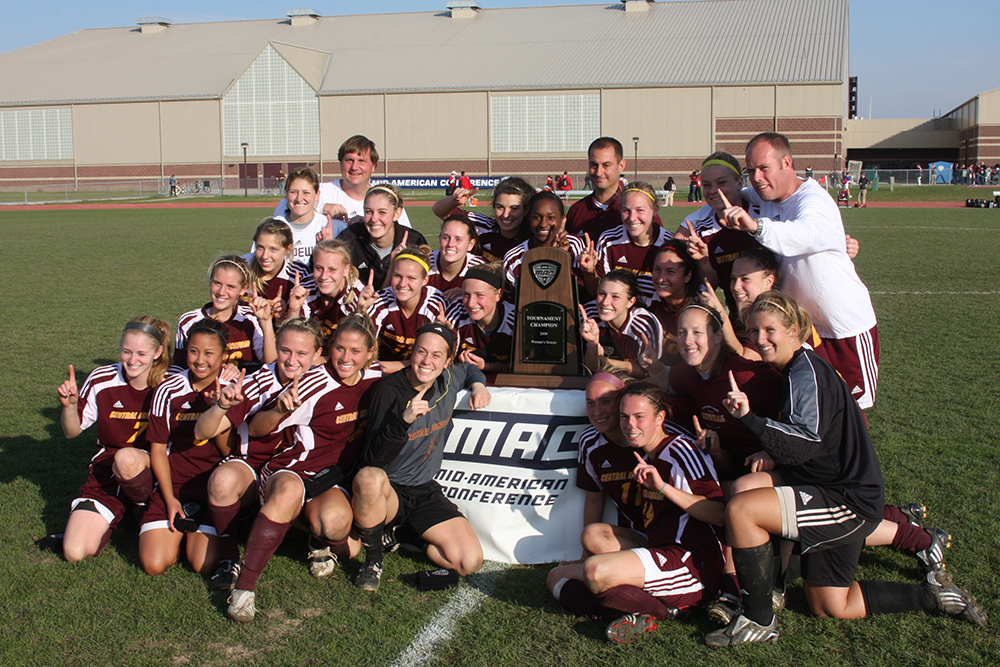AIAW to the NCAA
 |
| South Carolina and Louisiana Tech square off in the 3rd place game of the AIAW National Championship, 1980 |
Before the 1980s, women's athletics competed under a separate governing body from men: the Association of Intercollegiate Athletics for Women (AIAW). The AIAW not only oversaw the organization of women's college sports, but also awarded national championships in basketball, volleyball, gymnastics, softball, swimming and diving, and much more. Even after Title IX was enacted, the National Collegiate Athletic Association (NCAA), which only governed men's sports at the time, did not take interest in bringing women's sports under their umbrella, and the AIAW flourished in the 1970s.
CMU made a lasting mark on the AIAW during its time. Fran Koenig, Marcy Weston, Pat Podoll, and many of their colleagues led CMU while the university was part of the AIAW and as Central moved to the NCAA in the 1980s. The tradition of success was thanks, in no small part, to their tireless work to advocate for women's sports as something beneficial for athletes and schools and as a fan-friendly spectator event.
In 1977, CMU hosted the AIAW National Gymnastics Championships. Pat Podoll, faculty in physical education at CMU and meet director of the event, was instrumental in bringing the gymnastics championship to Central. The event was the first time that CMU was selected as the host for an intercollegiate athletics championship and the more than 7,000 people who attended were delighted by Central's operations. The two-day competition brought in compliments from athletes, coaches, and fans and thrust CMU into the national spotlight.
Three short years later, in 1980, CMU leadership once again won a bid to host a major AIAW competition: the National Championship for Women's Basketball. With Podoll again serving as coordinator of the event, it was a huge success, both financially and as an event in which some of the biggest names in women’s basketball history participated. Nancy Lieberman—professional basketball player, coach, and broadcaster—starred for Old Dominion, which faced off against the Tennessee team of Coach Pat Head (Summit) in the finals. Also competing were Anne Donovan, two-time Olympic gold medalist, and Lansing Everett High School star and South Carolina player Evelyn Johnson. Three of the women from the inaugural class of the Women's Basketball Hall of Fame (1999) were on the court, either as a player or a coach, during the championship game in Mt. Pleasant.
"Let's Go Back: The 1980 AIAW Final Four at Central Michigan University," WCMU Public Media
In 1981, the women's basketball Final Four tournament was held in Eugene, Oregon, and proved just as successful as when CMU hosted. By the next year, the NCAA began to realize the potential—in terms of the competition, the moves toward equity in sports, and the financial value—of hosting women's championships. In 1982, both the AIAW and the NCAA hosted women's basketball championships, and many powerhouse teams opted for the NCAA events. By 1983, the AIAW was no longer in operations and the NCAA became the governing body for women’s sports. For the first time in the United States, men's and women's sports were hosted by the same national organization.
 |
| CMU Soccer, 2009 MAC Champions |
Many argue that Title IX pushed the NCAA to take on the Women’s Final Four. It could also be argued that the achievement of the 1980 and 1981 championship games showed the NCAA that there was success to be had in investing in women’s sports. This idea has proven true, as there is no doubt that the NCAA has benefited significantly from women's sports. In 2019, women's basketball brought in $600 million worth of revenue for the NCAA.
Today, women across the country continue to compete under the NCAA, the largest collegiate sports association. The movement from the AIAW to the NCAA would not have been possible without the efforts of women such as Fran Koenig, Marcy Weston, and Pat Podoll, as well as all of the athletes, coaches, fans, and administrators.
